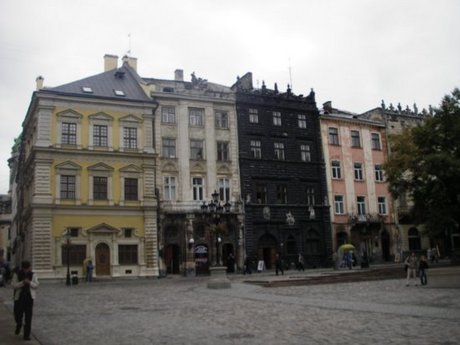Black House
Black House (Black Kamenica) is located in Lviv, at Market Square, 4. The building is the architectural monument of the XVI-XVII centuries and has no analogues not only in Lviv, but also throughout Europe. It is famous for its stones, grown dark with age. Its construction was started in 1588, three years after Italian (Venice) Patio was built next to Black Stone.
House by architect Peter of Barbone for Greek merchant, Constantine Kornyakt. It is not quite clear who designed the House: Petro Krasovskyj, Paul of Rome or Peter of Barbone. The upper floor and the sculptures of the facade were added in 1675-77 by architect M.Hradovskyj. The main entrance is decorated with beautiful stone-carving. Among the saints on the facade there is a statue of St. Martin,the patron saint of one of the house owners, doctor of Medicine - Martin Anchevsky
The Black House is a remarkable Renaissance building on the Lviv Market Square, in the city of Lviv, Ukraine. It was built for Italian tax-collector Tomaso Alberti in 1577. The architect was probably Piotr Krasowski. The Lviv Historical Museum has been housed in the Black House since 1926.
The façade is lined with sandstone which has darkened over the years to blackish brown. The front exhibits some fine decorative ornamentation. Jan Lorencowicz, having acquired the house in 1596, added another storey and opened one of the town's first pharmacies on the ground floor. The uppermost storey was added in 1884.
The building of Black House was erected in 1577 by architect P. Krasowski and bore the imprint of a living Renaissance architecture (some sources indicate 1588 as the date of commencement of construction, and P. Barbone and P. Rimlianin as the architects). In 1596, Black House becomes the private property of Jan Lorentsovich, who opens one of the first pharmacies in Lviv here. Thanks to him, there appears the third floor in the building; the fourth floor had being completed in 1884 on the site of the attic.
In the years 1675-1677 Black House was decorated with attic. On the facade of the building there appears the sculpture. This idea belonged to the architect M. Gradovsky. Now the facade combines the features of Italian and Polish Renaissance.
The facade of the Black Kamenica is paved with stone blocks, shaped like a diamond. It was adorned with ornaments and beautiful carved scene; there are the figures of saints on it - patrons of Medicine: St. Florian, St. Martin and Madonna. The corner pilasters and the facade are covered with hewn stone, blackened by time. Due to this phenomenon, the house got such a name, and a few years ago it was painted black.
The interior of the building was not particularly exposed to reconstruction: there preserved columns, covered with relief ornament, ceiling with cross beams, wide window sills and the original design of the entrance to the chapel.
In 1926, the building of the Black House was redeemed by the city, and in 1929 there was opened a branch of the Historical Museum.
The Market Square in central Lviv buzzes with activity day and night and is popular with both locals and tourists visiting this lovely city in Ukraine. The rectangular-shaped square boasts the majestic town hall which was built in 1835, complete with a 65-meter tower, and around the square there are forty-four tenement houses representing a wide variety of architectural styles ranging from Renaissance to Modernism. One of the most extraordinary, and famous, of these tenement houses is known simply as the Black House.
The Black House was built in the latter part of the 16th century for Tomas Alberti, an Italian tax-collector. It is widely considered to be one of the most superb examples of Renaissance architecture in Lviv. This is quite an accomplishment when taking into account the fact that Lviv is a veritable treasure trove of architectural marvels. Renaissance architecture, which was the dominant architectural style for buildings of note from the early 15th century through to the early 17th century, was first developed in Florence, but soon spread to other Italian cities and, as it gained in popularity, it spread to other countries, including France, Germany, England, Russia and Ukraine.
The entire front façade of the Black House was created from sandstone, which over years of exposure to the elements has turned a deep, rich charcoal-black. As house number four on the eastern side of the Market Square of Lviv, the Black House is flanked on one side by a Rococo-style house built for the Wilczek family in the 16th century and remodeled in 1772, while on the other side stands the House of Lukasiewicz, also built in the 16th century. The Black House stands out in stark contrast between its neighbors, the one of which is pink and white and the other light grey.
The Black House has four floors, and above the entrance and two ground floor windows are decorative fixtures, while along the edge of the roof-top are a series of decorative balustrades. Just opposite the Black House is a wide paved area of the square, with a lovely water fountain and trees, lending an air of tranquility to the surroundings - even though it forms part of the busy Market Square. Since 1926, the Black House has been cared for, and forms part of, the Historic City Museum of Lviv.
The Market Square is one of the places that most tourists visit when exploring Lviv, and the Black House stands proudly on the eastern side of the square, as it has done for centuries.




